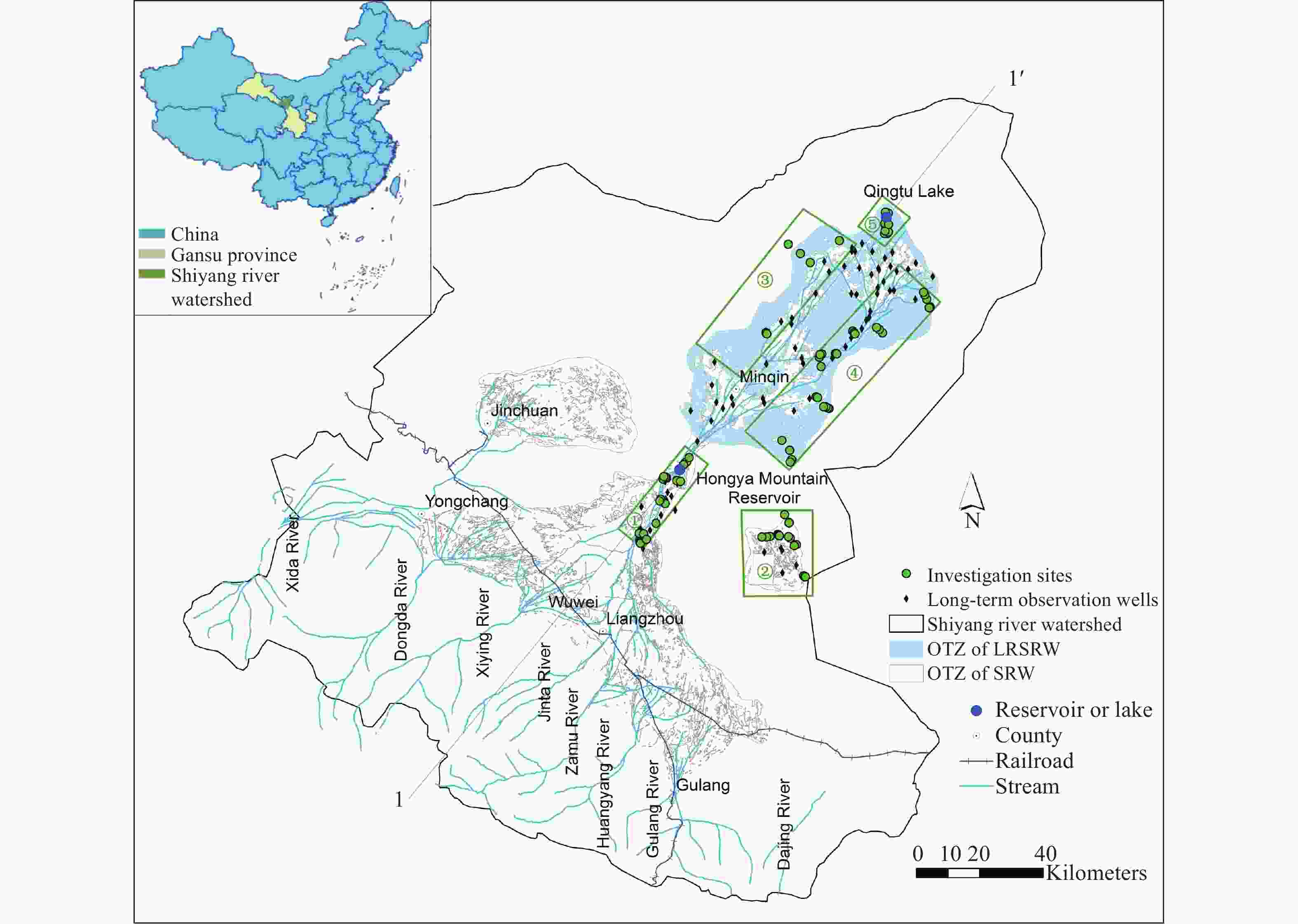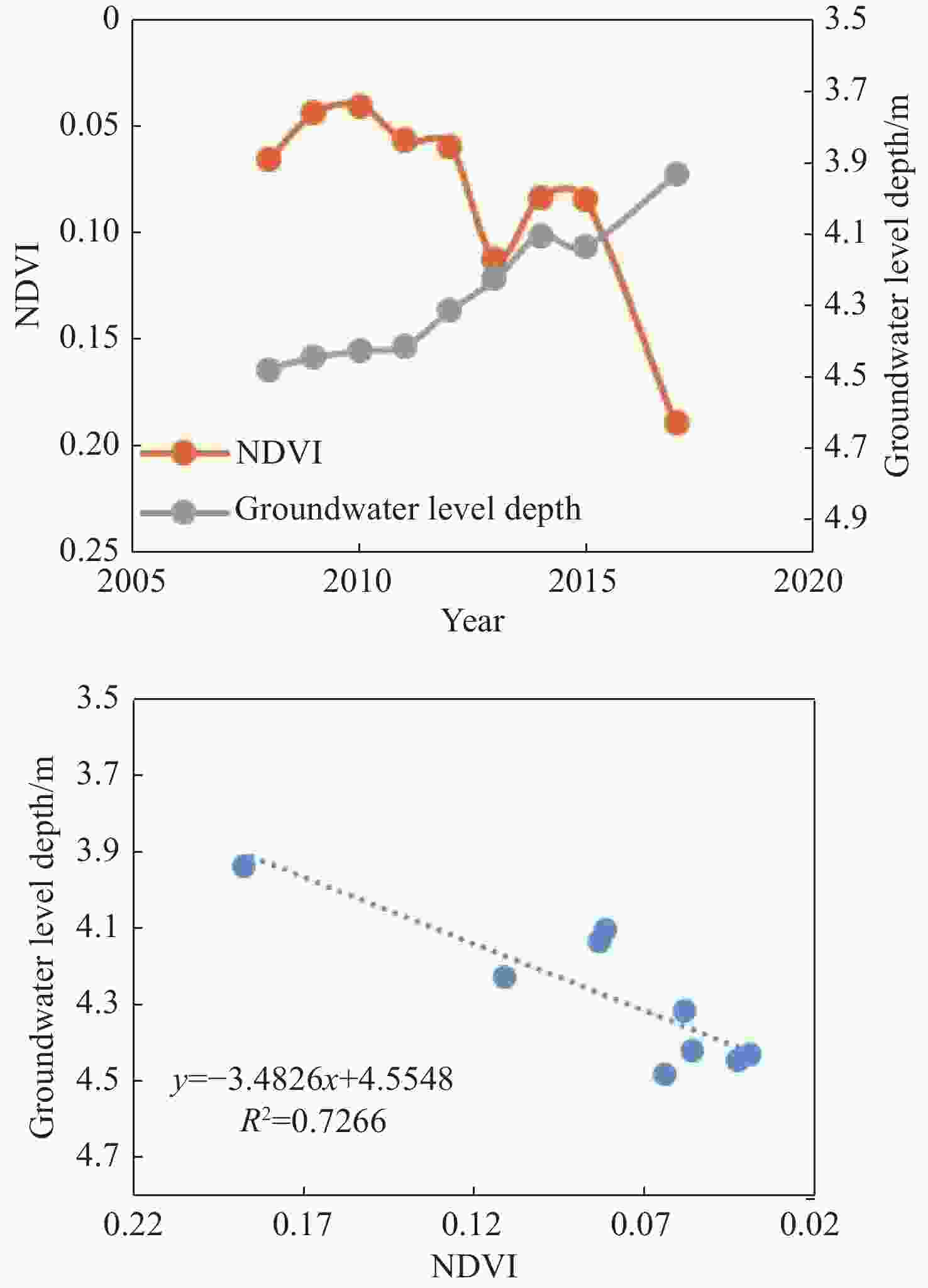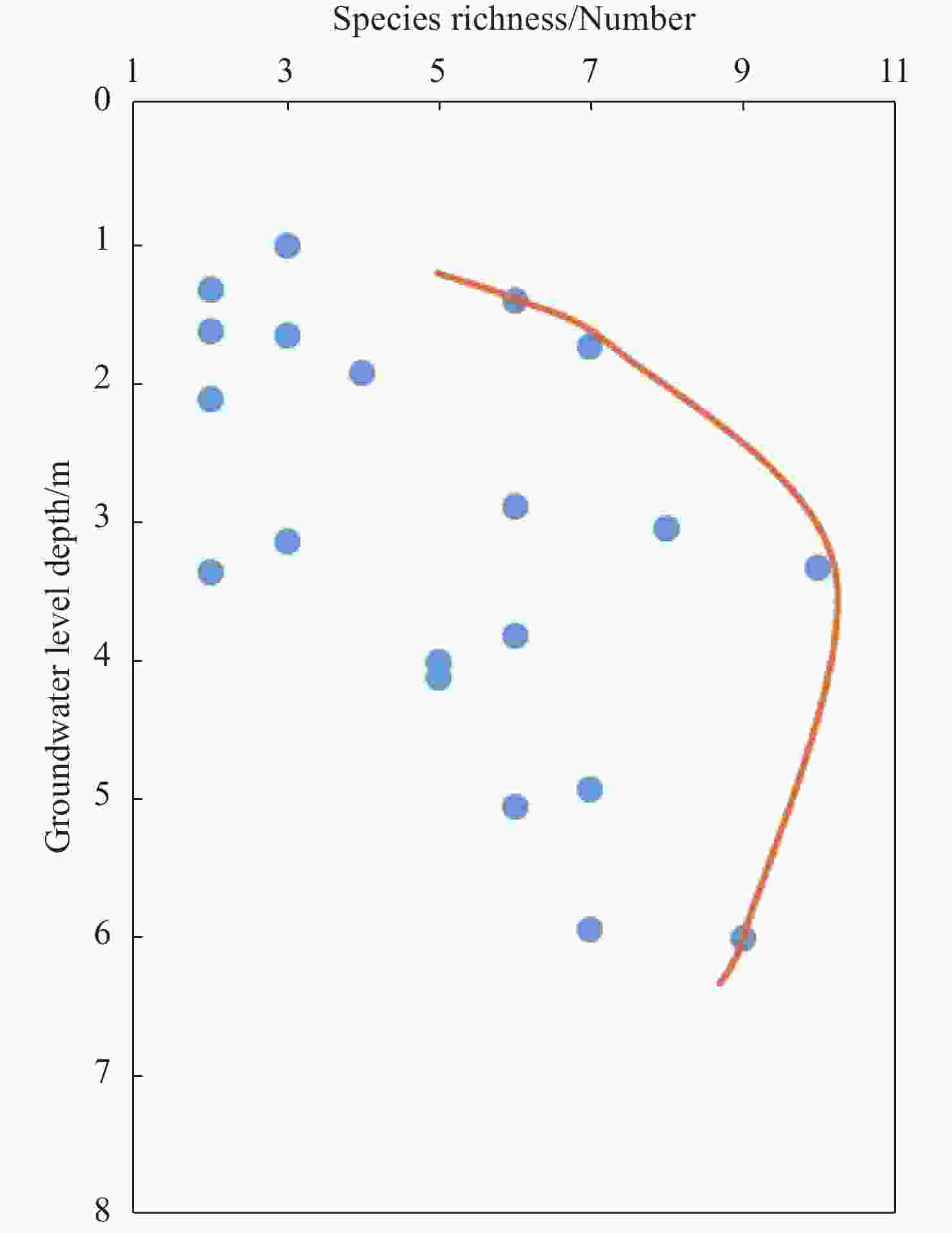Comprehensive evaluation on the ecological function of groundwater in the Shiyang River watershed
-
Abstract: With an arid climate and shortage of water resources, the groundwater dependent ecosystems in the oasis–desert ecotone of the Shiyang River Watershed has been extremely damaged, and the water crisis in the oasis has become a major concern in the social and the scientific community. In this study, the degeneration characteristics of the groundwater ecological function was identified and comprehensive evaluated, based on groundwater depth data, vegetation quadrat and normalized difference vegetation index (NDVI) from Landsat program. The results showed that (1) the suitable groundwater depth for sustainable ecology in the Shiyang River Watershed is about 2-4 m; (2) the terms of degenerative, qualitative and disastrous stages of the groundwater ecological function are defined with the groundwater depths of about 5 m, 7 m and 10 m; (3) generally, the groundwater ecological function in the oasis-desert ecotone of the lower reaches of Shiyang River Watershed is weak with an area of 1 397.9 km2 identified as the severe deterioration region, which accounted 74.7% of the total area. In the meantime, the percentages of the good, mild and moderate deterioration areas of groundwater ecological function are 3.5%, 5.5% and 16.3%, respectively, which were mainly distributed in the Qingtu lake area and the southeastern area of the Shoucheng town; (4) the degradation and shrinkage of natural oasis could be attributed to the dramatic groundwater decline, which is generally caused by irrational use of water and soil resources. This study could provide theoretical basis and scientific support for the decision-making in environmental management and ecological restoration of the Shiyang River Watershed.
-
Figure 1. Study area and the investigation sites
Note: SRB – Shiyang River Basin; LRSRB – the Lower reaches of the Shiyang River Basin; investigation sites – investigation sites of groundwater level depth and the ecological vegetation quadrat; ①②③④⑤represent the oasis–desert transition zones of the Hongyashan reservoir area, the South Lake area, the west of the Minqin irrigation area, the east of the Minqin irrigation area and the Qingtu Lake area, respectively.
Figure 4. Relationship between NDVI and groundwater level depth in the Oasis-desert ecotone (Cao et al. 2020)
Table 1. Relationship between groundwater level depth and the index of the dessert vegetation quadrats
Groundwater level
depth/mSpecies richness/No. Total coverage/% Dominant species Dominant species
height /m0-2 1-3 75-90 Tamarix spp. 3.8 Phragmites australis 1.0 Kalidiumfoliatum 0.6 2-4 2-7 45-100 Elaeagnus angustifolia 6.0 Tamarix spp. 2.6 caragana microphylla 2.2 3-6 3-10 30-70 Reaumuriasoongorica 0.6 hedysarumscoparium 1.2 5-7 2-4 20-30 Nitraria spp. 0.5 Reaumuriasoongorica 0.5 >7 1-2 <25 Haloxylonammodendron 1.2 Nitraria spp. 0.4 Table 2. Grading value of comprehensive evaluation index of groundwater ecological function
Index V1 V2 V3 V4 Groundwater level depth/m 2-4 5 7 10 NDVI > 0.7 0.2 0.13 0.08 Species richness ≥ 5 4 3 2 Abundance of the dominant species ≥ 5 4 3 2 Rating value 1 0.7 0.5 0.3 Note: when groundwater table depth was less than 2 m, its score was calculated in a linearly decreasing manner. For dominant species abundance, it may be scored 7 indicating “extremely abundant”, 6 “highly abundant”, 5 “abundant”, 4 “fairly many”, 3 “not many”, 2 “sparse”, and 1 “only one plant.” Table 3. Grading value of vegetation type index of groundwater ecological function
Vegetation type Value Arbor > Shrub > Herb 1.00 Shrub > Arbor > Herb 0.83 Arbor > Herb 0.67 Arbor > Shrub 0.83 Shrub > Herb 0.67 Shrub only 0.57 Herb > Shrub 0.50 Herb only 0.33 Table 4. The total score of groundwater ecological function comprehensive evaluation and its indication
Grading V1 V2 V3 V4 The total score >0.7 0.7-0.5 0.5-0.3 <0.3 Indication Good condition Mild degermation Moderate degeneration Severe degeneration -
Amus DE, Froend R, Loomes R, et al. 2006. A functional methodology for determining the groundwater regime needed to maintain the health of groundwater-dependent vegetation. Australian Journal of Botany, 54: 97-114. doi: 10.1071/BT05031 Cao L, Nie ZL, Liu M, et al. 2020. Changes in natural vegetation growth and groundwater depth and their relationship in the Minqin oasis in the Shiyang River Basin. Hydrogeology & Engineering Geology, 47(3): 25-33. (in Chinese) Cao L, Nie ZL, Liu M, et al. 2021. The ecological relationship of groundwater–soil–vegetation in the Oasis–Desert transition zone of the Shiyang River Basin. Water, 13(12): 1642. doi: 10.3390/w13121642 Cui Y, Shao J. 2010. The role of ground water in arid/semiarid ecosystems, Northwest China. Ground Water, 43(4): 471-477. Dong H, Ge LQ. 2015. Groundwater ecological environment and the mapping of Asia. Journal of Groundwater Science and Engineering, 3(2): 118-126. Fang JY, Wang XP, Shen ZH, et al. 2009. Methods and protocols for plant community inventory. Biodiversity Science, 17(6): 533-548. (in Chinese) doi: 10.3724/SP.J.1003.2009.09253 Glazer AN, Likens GE. 2012. The water table: The shifting foundation of life on land. Ambio, 41(7): 657-669. doi: 10.1007/s13280-012-0328-8 Guo ZR, Liu HT. 2005. Eco-depth of groundwater table for natural vegetation in inland basin, Northwestern China. Journal of Arid Land Resources and Environment, 19(3): 157-161. (in Chinese) Hao Y, Xie Y, Ma J, et al. 2017. The critical role of local policy effects in arid watershed groundwater resources sustainability: A case study in the Minqin oasis, China. Science of the Total Environment, 601-602: 1084-1096. doi: 10.1016/j.scitotenv.2017.04.177 Huang F, Zhang Y, Zhang D, et al. 2019. Environmental groundwater depth for groundwater-dependent terrestrial ecosystems in arid/semiarid regions: A Review. International Journal of Environmental Research and Public Health, 16(5): 763. doi: 10.3390/ijerph16050763 Huang XQ, Yu YQ, Sun YL. 2014. Construction of ecological environment of oasis in Qingtongxia Irrigation District. Journal of Groundwater Science and Engineering, 2(3): 78-84. Jia BQ, Ci LJ, Cai TJ, et al. 2002. Preliminary research on environmental characteristics of oasis desert ecotone. Chinese Journal of Applied Ecology, 13(9): 1104-1108. (in Chinese) Jin XM, Wang ST, Xia W. 2016. Response of vegetation to variation in climate and groundwater in the Qaidam Basin. Hydrogeology & Engineering Geology, 43(2): 31-36. (in Chinese) Jin XM. 2010. Quantitative relationship between the desert vegetation and groundwater depth in Ejina Oasis, the Heihe River Basin. Earth Science Frontiers, 17(6): 181-186. (in Chinese) Li X, Cheng G, Ge Y, et al. 2018. Hydrological cycle in the Heihe river basin and its implication for water resource management in Endorheic Basins. Journal of Geophysical Research Atmospheres, 123(2): 890-914. doi: 10.1002/2017JD027889 Liu H., Zhong HP, Gu Y. 2001. Water resources development and oasis evolution in inland river basin of arid zone of Northwest China — A case study: Minqin Basin of Shiyang River. Advances in Water Science, 9(3): 378-384. (in Chinese) Liu M, Nie ZL, Wang JZ, et al. 2014. Fuzzy comprehensive evaluation of groundwater resources carrying capacity in North China Plain. Bulletin of Soil and Water Conservation, 34(6): 311-315. (in Chinese) Liu SJ, Yuan HB, Liu SZ, et al. 2013. Relationship and variation of riparian vegetation species diversity and groundwater table in middle and lower reaches of Shiyang River. Research of Soil and Water Conservation, 20(05): 141-144. (in Chinese) Ma JZ, Wei H. 2003. The ecological and environmental problems caused by the excessive exploitation and utilization of groundwater resources in the Minqin Basin, Gansu Province. Arid Zone Research, 20(4): 261-265. (in Chinese) Ma XH, Wang S. 2005. Relationship between vegetation degradation and groundwater level and mineralization in Shule River Basin, Gansu Province. Journal of Gansu Forestry Science and Technology, 30(2): 53-54. (in Chinese) MacKay, Heather. 2006. Protection and management of groundwater-dependent ecosystems: Emerging challenges and potential approaches for policy and management. Australian Journal of Botany, 54(2): 231-237. doi: 10.1071/BT05047 Naumburg E, Mata-Gonzalez R, Hunter R G, et al. 2005. Phreatophytic vegetation and groundwater fluctuations: A review of current research and application of ecosystem response modelling with an emphasis on Great Basin vegetation. Environmental Management, 35(6): 726-740. Shi WL, Liu SJ, Liu SZ. 2017. Influence analysis of artificial water transfer on the regional ecological environment of Qingtu lake in the lower reaches of the Shiyang river. Acta Ecologica Sinica, 37(18): 5951-5960. (in Chinese) Wang F, Liang RJ, Yang XL, et al. 2002. A study of ecological water requirements in northwest China. Ⅰ: Theoretical analysis. Journal of Natural Resources, 17(1): 1-8. (in Chinese) Wang H, Zhang M, Zhu H, et al. 2012. Hydro-climatic trends in the last 50 years in the lower reach of the Shiyang River Basin, NW China. CATENA, 95: 33-41. doi: 10.1016/j.catena.2012.03.003 Wang XY, Chen XS, Ding QP, et al. 2018. Vegetation and soil environmental factor characteristics and their relationship at different desertification stages: A case study in the Minqin desert-oasis ecotone. Acta Ecologica Sinica, 38(5): 1569-1580. (in Chinese) Xiang M, Yao J, Wang JY. 2017. Effects of groundwater in Shajingzi region of Minqin lake area on vegetation succession of Desert. Protection Forest Science and Technology, 163(4): 46-47. (in Chinese) Xu HL, Song YD, Wang Q, et al. 2004. The effect of groundwater level on vegetation in the middle and lower reaches of the Tarim River, Xinjiang, China. Acta Phytoecologica Sinica, 28(3): 400-405. (in Chinese) Yang HD, Feng Q, Guo XY. 2017. Variation of groundwater depth and its influence factors in the Minqin Oasis in 1999-2013. Journal of Desert Research, 37(3): 562-570. (in Chinese) Yang J. 2018. Study on the relationship between vegetation and groundwater depth in desert oasis area of Shiyang River Basin. Gansu. Water Resources and Hydropower technology: 54(12): 1-4. (in Chinese) Yang XF. 2011. Study on the vegetation response to dynamic change of groundwater levele and climate changes in Minqin oasis. M. S. thesis, Northwest A$ F University: 39. (in Chinese) Yang ZH, Fang ET, Liu HJ, et al. 2007. Effect of water table to niche of plant population at Minqin oasis fringe. Acta Ecologica Sinica, 27(11): 4900-4906. (in Chinese) Yang ZH, Gao ZH. 2000. Impact of precipitation and underground water level in the edge of oases on growth and decline of Nitrariatangugtorum community. Chinese Journal of Applied Ecology, 11(06): 923-926. (in Chinese) Zhang CQ. 2017. Holocene environmental change and carbon cycle in endorheic basins – a case study in the Shiyang River drainage basin. Ph. D. thesis. Lanzhou: Lanzhou University: 15. (in Chinese) Zhang WH, Wei XM, Li YG. 2009. Groundwater dynamic evolution under climatic change and human activites in Shiyang River Basin. Research of Soil and Water Conservation, 16(1): 183-187. (in Chinese) Zhao P, Xu XY, Qu JJ, et al. 2017. Relationships between artificial Haloxylon ammodendron communities and soil-water factors in Minqin oasis-desert ecotone. Acta Ecologica Sinica, 37(5): 1496-1505. Zhu Y, Chen Y, Ren L, et al. 2016. Ecosystem restoration and conservation in the arid inland river basins of Northwest China: Problems and strategies. Ecological Engineering, 94: 629-637. doi: 10.1016/j.ecoleng.2016.06.107 -

 E-mail alert
E-mail alert Rss
Rss



 下载:
下载:














